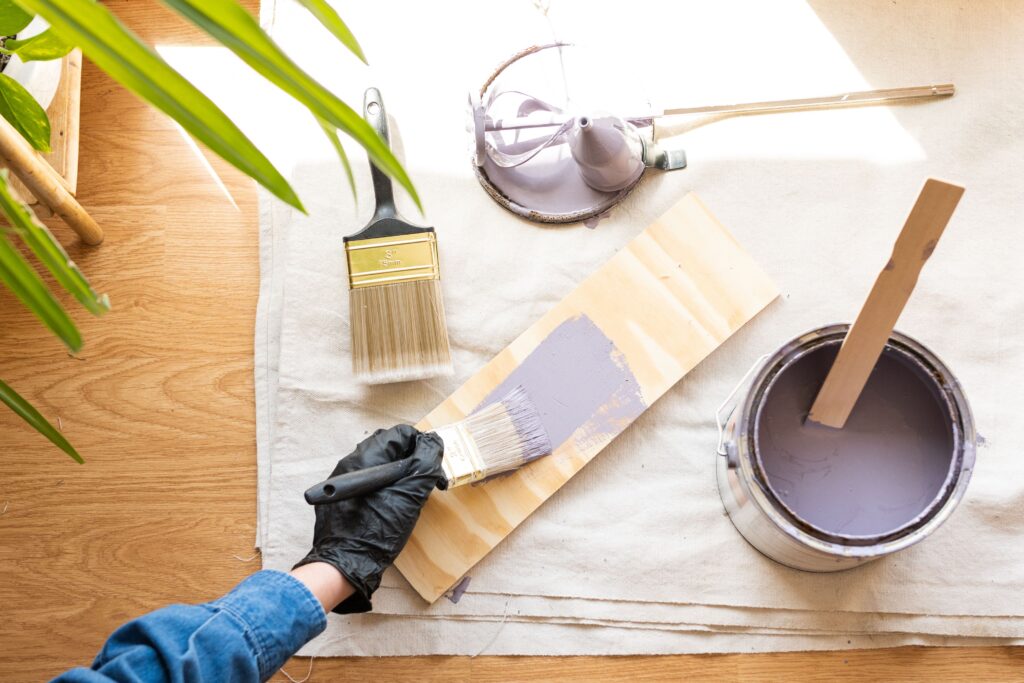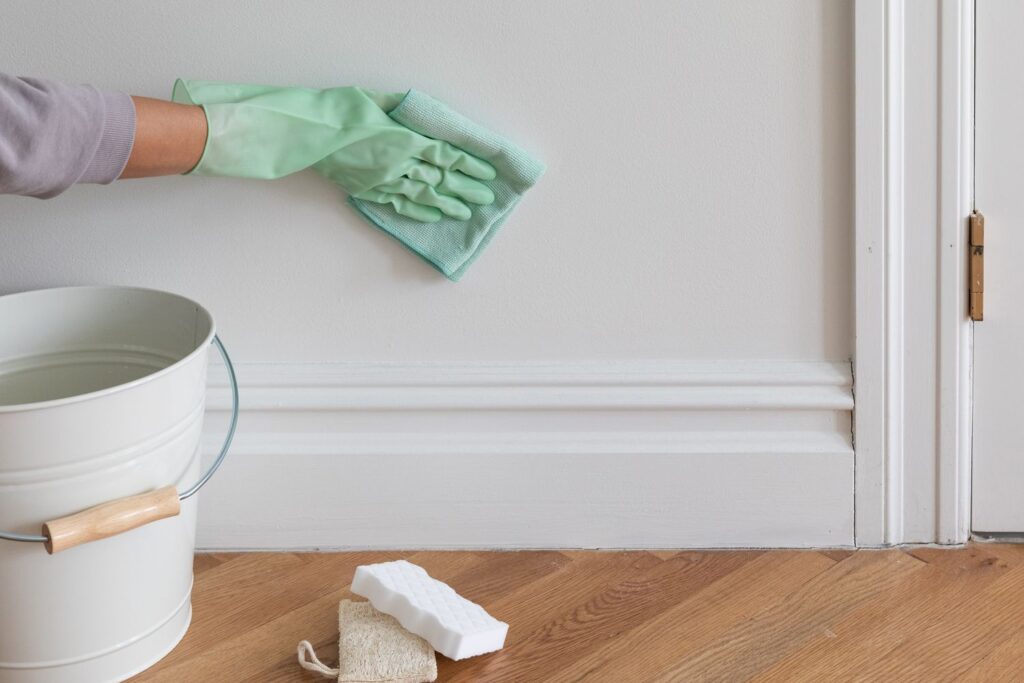Water-based, or latex paint is usually used for interior painting. Water is the primary solvent for this kind of paint, which makes it very easy to clean up and environmentally friendly. Latex paint made its debut in the 1940s as an alternative to oil-based paints. Today, latex paint comes in many forms with different properties and benefits, including acrylic latex, vinyl latex, and 100% acrylic.
Benefits of Applying Latex Paint on Interior Surfaces
One of the advantages that latex paint has in the interior painting is its low VOC. While painting, volatile organic compounds (VOCs) may be emitted into the atmosphere and have an adverse effect on one’s health. Latex paint contains significantly less volatile organic compound compounds (VOCs) than oil-based paints, making it safer for both the painter and the people who will occupy the painted space.

Secondly, latex paint is very easy to clean up. Since it is aqueous in nature, one only needs soap and water to clean the brushes, rollers as well as other painting tools. Not only does this save a lot of time, but it also eliminates the need for the abrasive solvents or thinners used to clean oil-based paint tools.
In addition, latex paint does not fade or become yellow after a while. This would mean that even with artificial or daylight lighting, your painted surfaces will continue to have bright colors for a long period of time. Also, latex paint comes in all kinds of colors which means that you can find the perfect shade for your interior design. It can be used for numerous tasks related to painting since it is very suitable for use on drywall, wood, metal, and concrete among other surfaces.
Cons of using Latex Paint in indoor painting
While there are several advantages of latex paint to consider, some disadvantages should not be overlooked. One of its main drawbacks is the fact that it’s not as durable as the oil-based paint. In areas where there is heavy traffic or are likely to be moist or humid, the latex paint would not hold for as long. Over time, it may become very susceptible to peeling off, chipping off, or cracking.
It is also very hard to touch up the latex paint. Integrating touch-up areas into the painted surface is sometimes very difficult due to the short drying time and different gloss levels. This could lead to uneven color dispersion or any visible touch-up marks.
Also, certain surfaces including glossy or oil-based painted surfaces may not accept the latex paint properly. To achieve better adhesion and sustainable effects, the appropriate surface preparation and priming may need to be done.
Last but not least, places with heavy foot traffic and constant washing or rubbing are very unsuitable for latex paint. Although it is easy to clean with mild soap and water, the paint can peel off or become dull if it is rubbed too hard or if it is exposed to harsh chemicals.
Considerations When Selecting Latex Paint for Interior Painting
As you choose the latex paint for your interior painting project, there are some things to consider. First, you need to decide on the surface that you want to paint on. Different surfaces could require different types of latex paint or some additional preparation. For example, a primer might be required to ensure sufficient adhesion when painting over an already-painted surface.
The intended finish should also be taken into account. There are three different sheen levels for latex paint: matte, satin, and gloss. Each finish has many different practical and decorative features. Although gloss finishes offer a stronger and much more reflective surface, matte finishes are better suited for hiding the imperfections.
In the choice of latex paint, the color selection is also a big issue. Reflect on the overall color scheme of your interior space and how the paint will either enhance or maintain its current decoration. Many paint manufacturers have color swatches or samples that can be used to show you what the final product will look like.
What else you can consider is your own budget. As a rule, latex paint is generally cheaper than oil-based paint; however, the brand, quality, and quantity needed for your job will all influence the cost.
Lastly, environmental aspects may influence the type of latex paint that you pick. Choose paints labeled low or no VOC to minimize the emission of dangerous chemicals into the environment. These paints are not only environment-friendly but also are safe for your health.
How to Paint With Latex Paints Inside the House
Use these pointers to get the best results while painting interiors using latex paint:
1. Before painting, clean up the surfaces well. This includes sanding, cleaning, and the repair of any defects or damages.
2. To ensure uniform and smooth paint application, consider investing in high-quality brushes and rollers. Cheap or obsolete tools may leave many brush marks or streaks on the painted surface.
3. Learn and apply the correct techniques, such as rolling in the overlapping strokes and cutting in (painting along edges). This will help you in creating the results that are professional-looking.
4. Surface prep is very necessary, especially if you are painting over porous or previously painted materials. A primer increases the durability of the paint and facilitates adhesion.
5. Allow each coat to dry very well. For the recommended drying periods, as per the manufacturer’s directions. Rapidly painting can cause the paint to flake off or even smear.
The maintenance and cleaning of latex-painted surfaces
Proper care and cleaning of the latex-painted surfaces enable them to look a lot newer for much more time. In most cases, a light soap and water cleaning suffices for the removal of dust, grime, or any stains. Abrasive cleansers and strong chemicals should not be used as they can really damage the paint surface.

The same kind and tone of latex paint used for the original application should be applied for the touch-ups. The color matching may become very challenging after some time, so keep a little bit of the paint left as a touch-up in the future.
In areas with high traffic and are exposed to wear, consider applying a protective lacquer such as shellac or clear polyurethane. These coatings provide an extra layer of protection against fading, scuffs, and scratches.
Conclusion
In conclusion, latex paint has numerous advantages for use when painting interior spaces. With its low concentration of volatile organic compounds, drying speed, cleaning ease, resistance to yellowing and fading, a wide range of colors available, and compatibility; it is a preferred choice for both professionals and homeowners.
However, it is also very essential to consider the latex paint’s limitations. Taking into account its shorter lifespan as compared to the oil-based paint, the possible need for additional coats, difficulty in performing touchups, limited adhesion on some surfaces and also being unsuitable for high-traffic areas when making your decision.
Factors such as the specific surface to be painted, the desired finish, the color choice, and also budget, as well as environmental considerations, must all be considered in choosing latex paint for your interiors. Ensure that suitable instructions for application and maintenance are followed to achieve lasting and also visually appealing effects.

